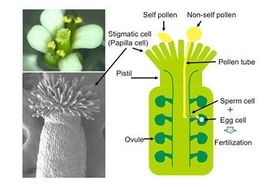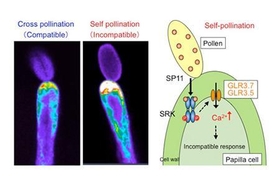Biological Science 2015/09/02
More than half of flowering plants avoid self-breeding and deleterious inbreeding depression via the 'self-incompatibility' system.
The laboratory of Intercellular communication led by Dr. Seiji Takayama in NAIST has succeeded in revealing the sophisticated mechanism of the self-incompatibility response, which enables the discrimination between self and non-self pollen by the stigma. Dr. Takayama's group utilized the model plant species Arabidopsis thaliana to elucidate the molecular details of the self-incompatibility response. Using the transgenic 'live-cell' calcium visualization line originally developed, the group showed that stigmatic cells import this ion upon self-pollen attachment, and also directly demonstrated that increase of cellular calcium ion induces responses for rejecting self-pollen. This import response of the calcium ions of the stigmatic cell was suggested to be mediated by the glutamate receptor channel, the well-known neural signaling ion gate protein molecules required for nerve activation, learning and memory.
For more information,
http://bsw3.naist.jp/eng/researchtopics/2015/20150902.html






